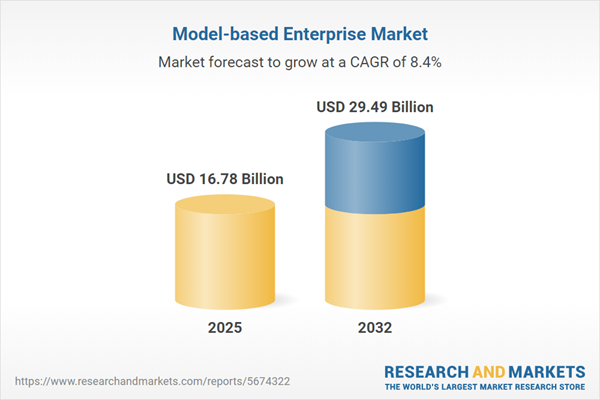Speak directly to the analyst to clarify any post sales queries you may have.
The model-based enterprise market is entering a dynamic phase, driven by industrial digitalization, new supply chain realities, and breakthroughs in simulation technologies. Senior decision-makers are seeking data-driven strategies to harness this evolution for operational efficiency and innovation at scale.
Market Snapshot: Model-Based Enterprise Market Overview
The model-based enterprise market grew from USD 15.50 billion in 2024 to USD 16.78 billion in 2025. It is projected to expand at a CAGR of 8.36%, reaching USD 29.49 billion by 2032.
This growth reflects rising adoption across core industrial domains, as organizations shift to digital-first processes and invest in resilient supply chain architectures.Scope & Segmentation of the Model-Based Enterprise Market
- Deployment Mode: Cloud (Hybrid Cloud, Private Cloud, Public Cloud); On-Premises
- Organization Size: Large Enterprises; Small and Medium Enterprises (Medium, Micro, Small Enterprises)
- Component: Services (Consulting, Support, Training); Solutions (Digital Twin, Model Based Design, Model Based Manufacturing)
- End User: Engineers; Production Managers; Quality Managers; R&D Departments
- Technology: 3D Modeling; Digital Twin; Model Based Definition; Virtual Reality/Augmented Reality
- Application: Collaboration; Design; Maintenance; Manufacturing; Quality Inspection
- Industry Vertical: Aerospace & Defense; Automotive; Consumer Goods; Healthcare; Industrial Machinery
- Geographical Coverage: Americas (North America: United States, Canada, Mexico; Latin America: Brazil, Argentina, Chile, Colombia, Peru); Europe, Middle East & Africa (Europe: United Kingdom, Germany, France, Russia, Italy, Spain, Netherlands, Sweden, Poland, Switzerland; Middle East: United Arab Emirates, Saudi Arabia, Qatar, Turkey, Israel; Africa: South Africa, Nigeria, Egypt, Kenya); Asia-Pacific (China, India, Japan, Australia, South Korea, Indonesia, Thailand, Malaysia, Singapore, Taiwan)
- Key Companies Profiled: Siemens Aktiengesellschaft, Dassault Systèmes S.A., PTC Inc., Autodesk Inc., SAP SE, Oracle Corporation, IBM Corporation, ANSYS Inc., Bentley Systems Incorporated, Altair Engineering Inc.
Key Takeaways for Senior Decision-Makers
- Organizations shifting from traditional practices to model-driven ecosystems foster real-time collaboration across engineering, manufacturing, and quality operations.
- Digital twin technologies and model-based definitions are unlocking greater innovation by enabling earlier anomaly detection and streamlined process validation.
- Hybrid deployment models are gaining traction as firms balance the scalability of cloud solutions with the control of on-premises infrastructure.
- Large enterprises leverage extensive resources for holistic adoption, while small and medium organizations benefit from phased approaches and targeted pilots.
- Industry leaders are prioritizing modular architectures and open standards, supporting interoperability with legacy and greenfield systems alike.
- Strategic partnerships and alliances across technology, consulting, and academic sectors are accelerating the model-based enterprise transformation.
Tariff Impact on Supply Chains and Investment Strategies
Recent United States tariff policies are prompting organizations to reconsider sourcing and manufacturing strategies, particularly regarding electronic components and machinery. This environment is leading to increased on-premises deployments in compliance-sensitive regions and spurring investment in automation and digital simulation. Firms are building more resilient, agile supply chains, emphasizing continued production agility and reduced logistical risks.
Methodology & Data Sources
This research leverages a robust multi-method approach. Primary insights were gathered from interviews with C-level decision-makers and technical leaders across manufacturing, quality, and engineering domains, supported by structured surveys tracking adoption trends. Comprehensive secondary research included analysis of industry reports, white papers, and technical standards to ensure the reliability and depth of findings.
Why This Report Matters to B2B Leaders
- Informs executive strategy on technology investment and digital transformation across operations.
- Supports risk-managed decision-making amid disruptive policy, supply chain, and regulatory changes.
- Equips leadership with actionable competitive benchmarking and identification of new growth opportunities.
Conclusion
The model-based enterprise is evolving into a cornerstone for operational agility and cross-functional innovation. Strategic adoption and continuous improvement position organizations to thrive as industrial digitization accelerates. This report delivers practical guidance for navigating the next phase of enterprise transformation.
Additional Product Information:
- Purchase of this report includes 1 year online access with quarterly updates.
- This report can be updated on request. Please contact our Customer Experience team using the Ask a Question widget on our website.
Table of Contents
3. Executive Summary
4. Market Overview
7. Cumulative Impact of Artificial Intelligence 2025
Companies Mentioned
The companies profiled in this Model-based Enterprise market report include:- Siemens Aktiengesellschaft
- Dassault Systèmes S.A.
- PTC Inc.
- Autodesk, Inc.
- SAP SE
- Oracle Corporation
- International Business Machines Corporation
- ANSYS, Inc.
- Bentley Systems, Incorporated
- Altair Engineering Inc.
Table Information
| Report Attribute | Details |
|---|---|
| No. of Pages | 196 |
| Published | October 2025 |
| Forecast Period | 2025 - 2032 |
| Estimated Market Value ( USD | $ 16.78 Billion |
| Forecasted Market Value ( USD | $ 29.49 Billion |
| Compound Annual Growth Rate | 8.3% |
| Regions Covered | Global |
| No. of Companies Mentioned | 11 |









